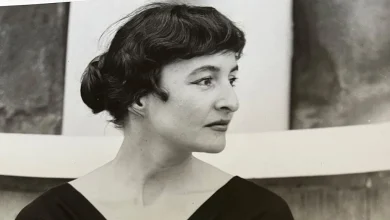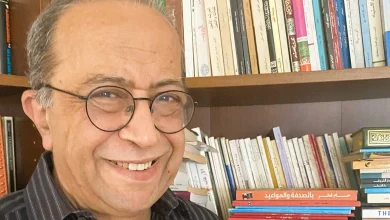“El Daif Ahmed” …From Tami al-Amdid to Her
When I was young, my cousin and I would go to play in a spacious yard near their house with the neighborhood kids in the village of Tami al-Amdid in the Dakahlia Governorate. Next to the yard was an old, dilapidated house, its walls worn away by time. We would jump over the wall to play inside and shelter from the heat of the sun for hours, then return to our homes. None of us knew anything about the owner of the house, nor did it ever occur to us to ask.
The days passed, with their ups and downs… I grew up and became more knowledgeable and interested in the artistic and cultural scene, and we used to boast that our country had produced a great artist who had been taken by death before he could become a great leader, as his peers, teachers, and admirers had predicted. That artist was Al-Dhaif Ahmed.
After some research, which I began by asking his relatives in my village, I tracked down all the information available about him on the internet and found pictures of the old house where I used to play as a child. In one of the photos, the old door appeared, and my memory came flooding back: this is where we used to play, this is where we used to have fun in our childhood days. The question remained pressing: who was this star who emigrated to Cairo, the capital of art and culture? What was the nature of his relationship with Tamim al-Amid? And most importantly, what was the connection between that mysterious house and my childhood?
From his birth to his pre-university years
I began gathering information from the villagers about the guest Ahmed Al-Deif, who was born on February 12, 1936, into a family of seven children, to his father Hajj Ahmed Al-Deif, who was the mayor of the village at the time, according to what some of the villagers told us. His family belonged to the Al-Sharaifa family, one of the largest families in the village, It is believed that they are descended from the Ashraf family of the House of the Prophet.
My sources did not provide me with sufficient details about this early stage of his life, nor did they clarify the nature of the education that the children of the village received in the 1940s. Nevertheless, we can imagine his early upbringing in general terms, based on what was common among the children of the Delta countryside at that time.
He most likely received his early education in the village kuttab (elementary school), which were common in villages at the time. He may have memorized the Quran or parts of it and learned to read and write. This is reinforced by what I noticed in some of his early works, where he read Arabic texts with eloquent language and correct pronunciation, indicating a well-rounded upbringing and prior knowledge of Arabic phonetics, which was most likely acquired in the village school.The place of this upbringing was, in all likelihood, the village school. It may have been there that he acquired the education that later enabled him to attend primary and then secondary school.

Three Lights of the Stage
From Primary to Secondary School
I also found nothing to indicate the name of the primary school that the guest attended. Was there even a primary school in the village at that time? However, sources agree that he passed from primary to secondary school. Research shows that there was no secondary school in the village before 1969, the year in which the Tami al-Amid Secondary School was established, which still exists today.
I think he enrolled in one of the schools in Mansoura or Sinclair. Both cities are about the same distance from his village, are more developed, and were connected by a railway line before it was removed around 1986. It is to be expected that the village mayor would be keen for his son to receive the best possible education.
At this stage, the guest’s personality began to take shape. He started acting in his high school theater, and schools at that time were very interested in such activities, which also suggests that his school was outside the village. This may have allowed him to travel and see people outside the village and interact with different social classes. From the poor and beggars on the sidewalk to the educated teachers at school. In addition to his rural upbringing, the contours of the future he hoped for after high school began to take shape. He then began a new phase far from the village, moving to Cairo, the capital of Arab culture and the center of literature and the arts, where he enrolled in the Faculty of Arts at Cairo University.
Eldaif on the stage of the Faculty of Arts
The guest Ahmed enrolled in the Faculty of Arts in 1956, as we learned from sources that almost unanimously agree that he graduated in 1960. We have information that gives us a good picture of this stage of his life. His friend Farouk Floks recounted: “I met Al-Dhaif in 1956 when we were students at Cairo University. We formed a troupe called Al-Dhaif and Floks, and we performed comedy sketches. I worked in a play called The Brothers Karamazov, which he directed. He was a brilliant director.”
In an interview with Al-Kawakeb, he said: “He was a friend of mine at university, and we shared work everywhere, even writing a comedy play in English, which was an extraordinary success. He was a giant in comedy, a director at the university, a lover of world literature, and enjoyed directing).
In an interview with the great writer Tharwat Abaza, hosted by Salwa Hijazi (an excerpt of which was posted on YouTube), the guest explained his philosophy of humor, He stated that he studied philosophy and psychology at university, contrary to what some sources claim that he graduated from the sociology department, and emphasized that these studies provided him with the knowledge that enabled him to reach and influence the masses.
Rise to stardom
The guest graduated from university in 1960, as I mentioned. He then took off until 1963, which was a turning point in his life. He appeared in a number of films in minor roles, but they were enough to engrave his talent in the minds of viewers. This is evident in a scene lasting no more than a minute and a half, in which he appeared with Rushdi Abaza in the film Arus al-Nil (Bride of the Nile). We all remember the words of that madman: “Why me? When? How? … I came from space, without a ship…”
In the same year, Fouad Al-Mohandes chose him to participate in his famous play with Shwikar and Adel Imam: Ana wa Huwa wa Hiya (Me, Him, and Her). The professor had previously discovered Al-Dawf when he saw him on the university stage. He was impressed by him and predicted a great future for him.
After that, he appeared in numerous films and plays until his untimely death, most notably: the play (Tabikh al-Mala’ika) in 1964 with his friends Samir Ghanem and George Sidhom, which made the trio famous.
Samir and Saidhom
In 1967, Al-Daiif officially joined the duo Samir and Sayed to replace the artist Adel Naseef, who had participated with them in the show “Doctor Al-Haqqani.” He then separated from them. The duo searched for a third member and first went to Farouk Floks, who apologized to them because he was busy. He recommended his talented friend Al-Daif Ahmed, who became the creator of the idea for the trio Adwaa Al-Masrah. Moreover, he directed some plays for the group, including Kul Wahed Lahu Afreet (Everyone Has a Genie), and wrote many of their sketches and jokes. Some sources even mention that he attempted to compose some songs for the group.
Many artists have confirmed his importance and prominent role in the trio, including Adel Imam, Farouk Floks, Lubna Abdel Aziz, and Osama Abbas, who said: “He was the mastermind of the trio and always led the rehearsals.”In the same year, the trio appeared in leading roles in the film 7 Days in Heaven, alongside Hassan Youssef, Najat, and Abdel Moneim Madbouli, directed by Hossam El Din Mostafa, and the film was a resounding success. In 1968, the trio appeared for the first time on Egyptian television in Fawazir Thalath Adwaa Al-Masrah (Three Riddles of the Stage Lights), followed by Fawazir: Wahawi Ya Wahawi (Riddles: Wahawi Ya Wahawi) in 1968, which inspired all the famous riddles that followed.
The early end
Al-Dai Ahmed remained on this path, giving tirelessly, until 1970, when his life was cut short at the height of his fame. He died young, at the age of 34, leaving behind his wife, Nabila Mandour, whom he had married a few years earlier, and his only daughter, Rasha, whom he loved madly. Fate did not allow him to see her grow up and blossom, and he also left behind many works and projects in progress. He passed away without achieving what he had hoped for himself and what his teachers, colleagues, and loved ones had hoped for him.
I will never forget the day we attended the funeral of one of the village boys. I was with my friend Ahmed Al-Daif, who was a relative of the deceased. We visited his relatives and stood at the grave of his father, who had also passed away early. Perhaps he was named Al-Daif after the great guest.
Then he pointed to an unmarked grave and said, “Do you know who is buried here?” I was surprised by his question and said, “No.” He said, “It is the grave of Al-Dhaif Ahmad, the famous actor.” We approached the grave and recited the Fatiha. It was interesting that I knew the grave of Al-Dhaif before I knew the house where the mayor grew up. After that, the family took him in as a guest on special occasions.
It is as if it is predestined and written that some great people will not be recognized for their greatness. They are only rediscovered after they have passed away, and their names are placed on a shelf in the closet (of beautiful memories). Crowned with regret, tears, and lamentations.

The Stage Lights Trio
At that time, the Stage Lights Trio was in Jordan filming a play directed by the guest himself, entitled The Man Who Married His Wife. After the trip ended, they all returned. And the guest returned… But he returned to be buried in the village where he was born and raised, and which had watched his success and fame from afar. This time, it witnessed his departure forever, following a sudden heart attack.
He returned to the village that had witnessed his beginnings, and I was left with some questions that I could not find satisfactory answers to, including: What was the guest’s relationship with the village he had abandoned? Did he abandon it out of hatred? Or was he just following his dream? Did his relationship with it end after he became famous and renowned? Or was he loyal to it until the end? Did he plan to return? But in the end, he returned involuntarily, a corpse buried in the dust of Tami al-Amid.
Another pressing question remained: Why was no marble slab placed on his grave to guide visitors? Did his family deny his death, unable to accept the painful reality that had taken him from them in the prime of his youth? Did they unintentionally refuse, or did their hearts refuse to write on his grave after he was buried: “Here lies the late Ahmed Al-Dhaif, 1936-1970”? To preserve his memory, the village hung a plaque above the entrance to his old house with the words: “Here lived Ahmed Al-Daif.”
Read also:






Hi, this is a comment.
To get started with moderating, editing, and deleting comments, please visit the Comments screen in the dashboard.
Thanks for sharing. I read many of your blog posts, cool, your blog is very good.